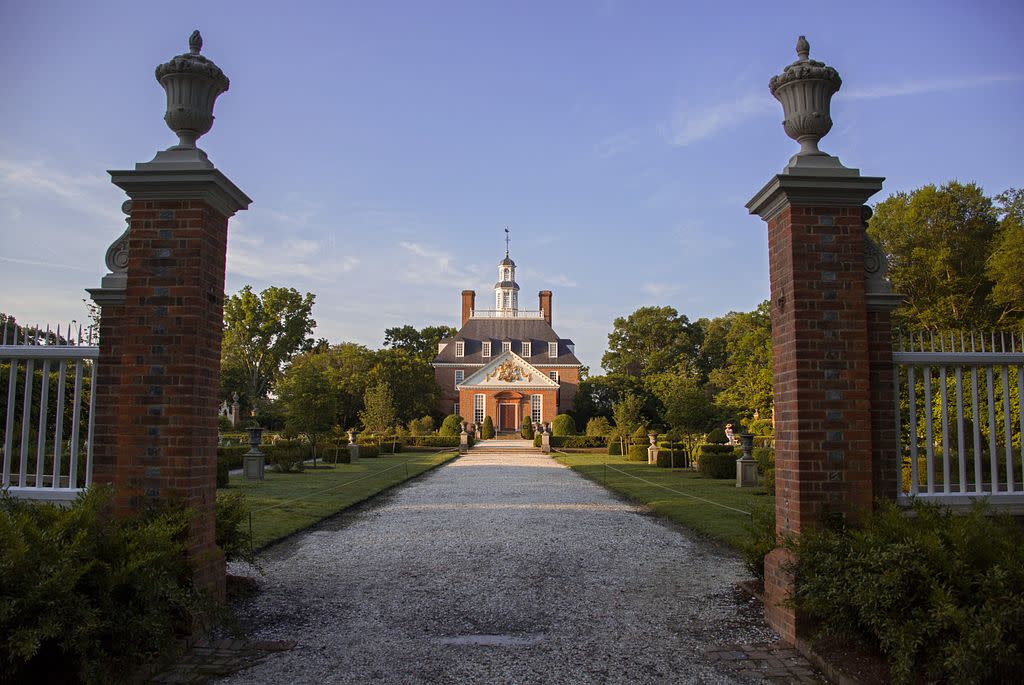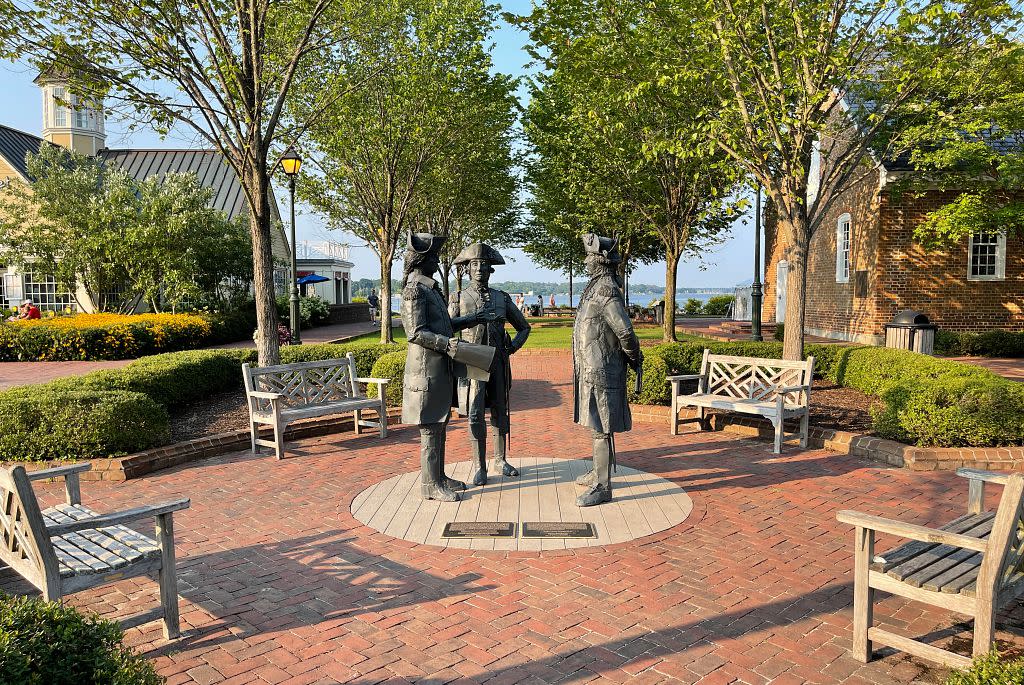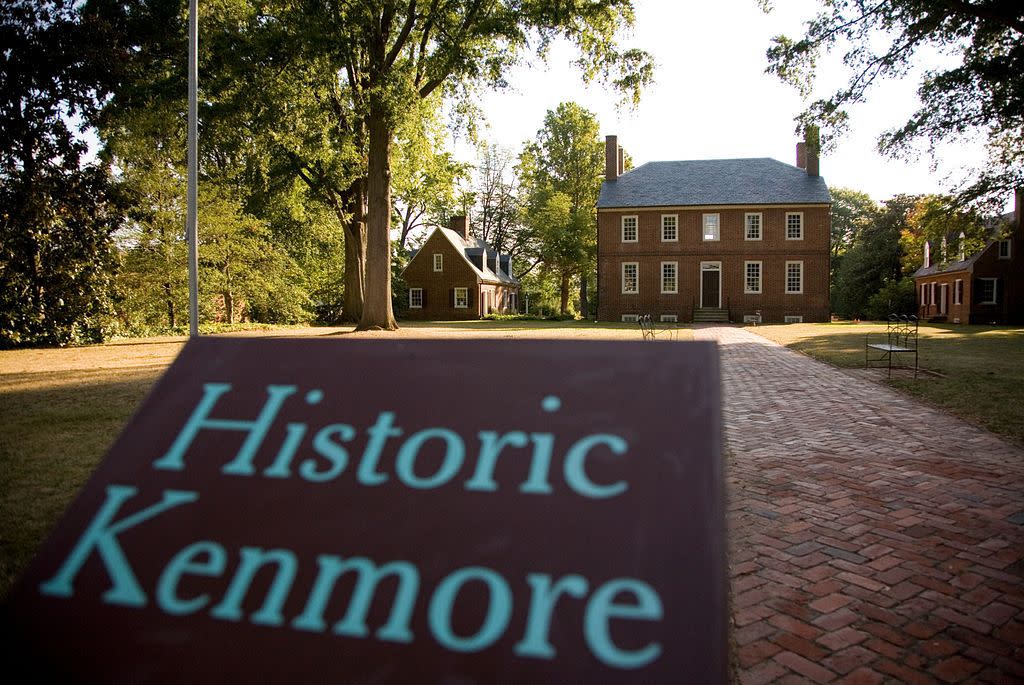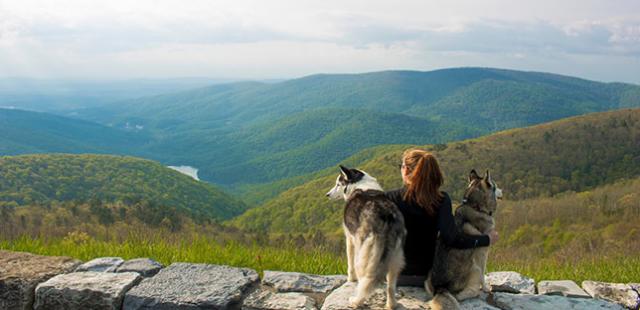Virginia is home to the first Colonial America settlements, as well as one of the original 13 colonies in America. With 400 years of history within its borders, there are plenty of towns in Virginia that are deeply connected to the Colonial era, the time period between 1607 and 1779 before the colonies gained their freedom from Britain to become the United States. Visit a few of these eight historic Virginia towns to get a peek at what Colonial life was like in the New World.
WILLIAMSBURG

When the first colonists traveled from Britain, they built the first English-speaking settlement in the New World at Jamestown, choosing the area as the perfect spot. Their requirements demanded that any new settlement be bordered by protective waterways, have deep shorelines allowing for boats to dock close to land, and be far enough inland to ward off any possible attack by Spanish fleets. Jamestown fit all three criteria, and became the capital of the New World from 1607 to 1699.
This historic settlement was eventually abandoned and the capital moved to Williamsburg, but you can still visit the original Historic Jamestowne on an archaeological walking tour to see the lands that the early colonists called home. Then, get an idea of daily life at the Jamestown Settlement in Williamsburg, a 17th century living history museum that tells about the lives of Indigenous peoples before the British arrived, the first colonists, and their eventual interactions together in the region.
Early Colonial settlers began establishing homes around the Williamsburg area by the 1630’s, leading to an exodus of Indigenous peoples who moved further inland in search of more remote locations. The colonists realized that the region was a strategic location, with the York River to the north and the James River to the south.
Visitors can learn all about Williamsburg during its time as the capital at Colonial Williamsburg, another living history museum built on much of the foundations of the original capital. The massive recreated village teaches of the historic trades practiced during the time period and even features some notable historic figures that tell of their pivotal roles in American history.
Williamsburg became one of the first planned cities in America after its designation as the capital of the Virginia Colony, drawing colonists to live, work, and learn in the area. The founding of William and Mary in 1693 made it a prime destination for some of the brightest minds of the time, with future Presidents Thomas Jefferson, James Monroe, and John Tyler all attending the college.
Historic Colonial Sites in Williamsburg:
- Historic Jamestowne
- Jamestown Settlement
- Colonial Williamsburg
- Church on the Main
- Wren Building & William & Mary Campus
- Bruton Parish Church
YORKTOWN

One of the eight original shires formed in Colonial Virginia in 1682, Yorktown was first established as York. The site is known today as one of three sites in the Historic Triangle, with Williamsburg and Jamestown forming the other two points of the triangle and all three connected by the Colonial Parkway. The area was settled by English colonists informally around the same time as Williamsburg, but it was officially founded as “York” in 1691, becoming a port on the York River that was used to transport tobacco to Europe, a practice that would steadily grow in the following century.
The town rose in importance as exports increased, reaching the height of its development in 1750. At the start of the American Revolutionary War, York was seen as an important location for the British, and General Charles Cornwallis used the area as a base of operations during the Siege of Yorktown, the last major battle of the war. Immediately after the American Revolution, York was renamed as Yorktown, and the town began to rebuilt and reestablish under American rule.
Tour the American Revolution Museum at Yorktown to discover the stories of soldiers that fought in the war for independence through exhibits, films, and living history performances, then travel down the road to the Yorktown Battlefield to see the site of the famous Siege of Yorktown.
Historic Colonial Sites in Yorktown:
- American Revolution Museum at Yorktown
- Custom House
- Grace Church
- York County Historical Museum
- Colonial National Historical Park
- Yorktown Battlefield
- Nelson House
RICHMOND

Photo Credit: Bill Crabtree Jr.
Like many other areas along Virginia’s James River, Richmond was explored by colonists soon after landing in Jamestown. Discovering Indigenous peoples living on the lands, they made contact but returned to Jamestown afterwards. Decades went by with the English colonists making only short expeditions to the region, but in 1673, William Byrd I gained a grant for the lands along the James River that would eventually be called Richmond. His son, William Byrd II, inherited the lands, but in the early 1700’s, the population of the small town was still below 200 colonists. It wasn’t until 1737 that a street plan was laid out for a full town, and Byrd would dub the lands “Richmond”, in tribute to Richmond, England, due to the view of the James River curving through the landscape seen from what is now Libby Hill Park.
Richmond received an official town charter in 1742, and quickly grew to become a hotspot for political and influential figures. Patrick Henry would give his famous “Give Me Liberty or Give Me Death” speech in 1775 at St. John’s Church in the Church Hill neighborhood of Richmond, which is still standing and open for tours today. This speech ignited the colonists’ desire for independence from British rule and would convince Virginia’s House of Burgesses to pass a resolution that would send troops to fight in the American Revolution. As the town’s population grew, so did its importance in the Virginia colony. In 1780, the capital of Virginia officially moved from Williamsburg to Richmond, where it has remained since.
Historic Colonial Sites in Richmond:
WINCHESTER

Photo Credit: Robert Harris, @robertharris
Located in the northern part of Virginia’s Shenandoah Valley, Winchester was first documented by colonists when German explorer John Lederer trekked the region in 1670. More thorough charting and mapping of Winchester occurred in the early 1700’s, first by Swiss explorer Louis Michel in 1705 and then by Governor Alexander Spotswood in 1716. By the late 1720’s, colonial settlements were being highly encouraged around the Winchester area, with expansive land grants given out to colonists by the then-Governor of Virginia, William Gooch.
Due to the generosity of these land grants, an inrush of settlers occurred in 1729, with large groups of new immigrants, including Quakers, Germans, and Scots-Irish, traveling south from Pennsylvania and New York to take advantage of the offer. While Virginia was technically an Anglican colony, Governor Gooch promoted tolerance of religion, allowing for several religious groups to coexist in Winchester. As a result, the area became home to some of the oldest Presbyterian, Quaker, Lutheran, and Anglican churches in the valley. While the region was previously known as Frederick Town, it was granted a charter by the Virginia House of Burgesses and renamed Winchester in 1752 for the English hometown of Colonel James Wood, the area’s first County Clerk.
During the French in Indian War, General George Washington traveled to Winchester in 1756. Washington, granted land by Colonel Woods, designed and constructed Fort Loudoun in present-day downtown Winchester as a base for military operations. The colonial structure would be occupied and manned until the start of the American Revolutionary War.
Historic Colonial Sites in Winchester:
- Site of Historic Fort Loudoun
- Old Stone Presbyterian Church
- George Washington’s Office Museum
- Opequon Presbyterian Church and Cemetery
- Mount Hebron Cemetery
- Museum of the Shenandoah Valley
- Abram’s Delight Museum
NORFOLK

Photo Credit: Matt King, @matt.king4
The colonial history of Norfolk as a modern settlement began in 1636, but the town was not formally established until 1680 and not incorporated in the Colony of Virginia until 1736. As soon as colonists moved to the region, however, they recognized its strategic military placement due to its location at the mouth of the James River and the Chesapeake Bay. In 1673, the colonists built Half Moone Fort, which is now where Town Point Park sits on Norfolk’s downtown waterfront. No traces of this early fort remain, but the location was used once again by British forces during the American Revolution to erect another temporary fort that would limit access to the waterways.
By 1775, Norfolk was one of the most prosperous cities in Virginia, functioning as a major shipbuilding center and a port city that exported goods like tobacco, corn, cotton, and timber from Virginia and other southern colonies and imported manufactured goods from Britain and other European countries that would be sent throughout the colonies.
The American Revolution reached Norfolk in 1776, and the town was burned to the ground by retreating British forces under orders of the outgoing colonial governor. Americans took control of the town and rebuilt, creating a thriving port town that by that still brings massive ships to the shores of Virginia today.
Historic Colonial Sites in Norfolk:
- St. Paul’s Episcopal Church
- Hampton Roads Naval Museum
- Town Point Park
PETERSBURG
By 1635, early colonists had traveled to the region that is now Petersburg and settled along the banks of the Appomattox River, which connected conveniently to the James River north of the town. Around 1675, a trading post named Peter’s Point began operations in the region, trading goods, food, and other items with the local Indigenous peoples as well as other nearby Colonial settlements.
The early settlements were haphazardly laid out, with very little cohesion or thought to proper structure. By 1733, Colonel William Byrd II, who also founded Richmond, drew up the plans for a fully organized town in the area, changing the name from Peter’s Point to Petersburgh (changed to Petersburg afterwards), and in 1748, the new town was officially incorporated into the Colony of Virginia.
During the American Revolutionary War, the British attempted to regain control of Petersburg, leading to the Battle of Blanford in 1781 just east of the town’s borders. While the American forces retreated back to Petersburg, the British never regained control of the area, and Petersburg stayed in American hands throughout the rest of the war.
Historic Colonial Sites in Petersburg:
FREDERICKSBURG

Photo Credit: Bill Crabtree Jr.
The exploration of Fredericksburg by colonists dates back to 1608 when Captain John Smith journeyed through the region, writing about his encounters with the Indigenous settlements. In the following decades, many more Colonial groups would travel through the area intermittently, and 1671, Sir William Berkeley granted a patent for 50 acres of land at the falls of the Rappahannock River, a tract that would become the center of Fredericksburg.
This new settlement received an official charter from the House of Burgesses in 1727 and was named Fredericksburg for Frederick, Prince of Wales. The town began to grow gradually due to the rise in tobacco exports, becoming the seat of Spotsylvania County in 1732. Tobacco exports increased over 150% between 1733 and 1773, and Fredericksburg’s population growth mirrored the boom. This burgeoning town served as an inspection point for exports like tobacco and was also an integral trade location along the Rappahannock River where European exports would arrive and be stored until further travels. A ferry service between Stafford and Fredericksburg began in 1784, solidifying both towns as port and commercial centers for the northern part of the Virginia Colony. As the booming trade town grew, retail merchants positioned themselves near the port to sell these goods as they came in, and craftsmen, doctors, lawyers, and tradesmen followed the merchants to provide their services.
Fredericksburg also became an important city during the years leading up to the American Revolution, acting as a meeting ground for patriots. The Rising Sun Tavern was originally built in the Colonial era as the home of George Washington’s youngest brother, Charles Washington. After Washington moved to found Charles Town, West Virginia, the property became a Federal Tavern, welcoming guests to the bustling port town of Fredericksburg. The building still stands as a museum to the era today. By the time the independence from Britain came, Fredericksburg was one of the largest towns in the Colony of Virginia.
Historic Colonial Sites in Fredericksburg:
- Rising Sun Tavern
- Mary Washington House
- Hugh Mercer Apothecary Shop
- James Monroe Museum
- Historic Kenmore
- George Washington’s Ferry Farm
ALEXANDRIA

Photo Credit: Dayo Kosoko for @visitalexva
Located just north of George Washington’s colonial estate, Mount Vernon, Alexandria began its Colonial history in 1669 when Sir William Berkeley granted an English ship captain roughly 6,000 acres in the region. However, less than a month later, the captain would sell and parcels of the lands would continue trading hands for the next few decades. During the end of the 1600’s, settlements began to spread further north, with Fredericksburg as a focal point for the region.
As the profitability of tobacco continued to rise, the northern section of the Virginia colony expanded and a warehouse was built along the bluffs of the Potomac River to house the cash crop before transportation. Captain Philip Alexander II farmed much of the remaining waterfront property, but during the 1740’s, the neighboring residents of Fairfax began to realize the need for a port to ship the grains and other crops grown in the farmlands to the west. Although Alexander at first resisted the petition to place their new town on part of his land along the Potomac River, the townspeople offered to name the new town Alexandria in honor of Philip’s family, and he accepted. The town was officially incorporated into the Virginia Colony in 1779, becoming a port of entry and a major export center.
Historic Colonial Sites in Alexandria:


